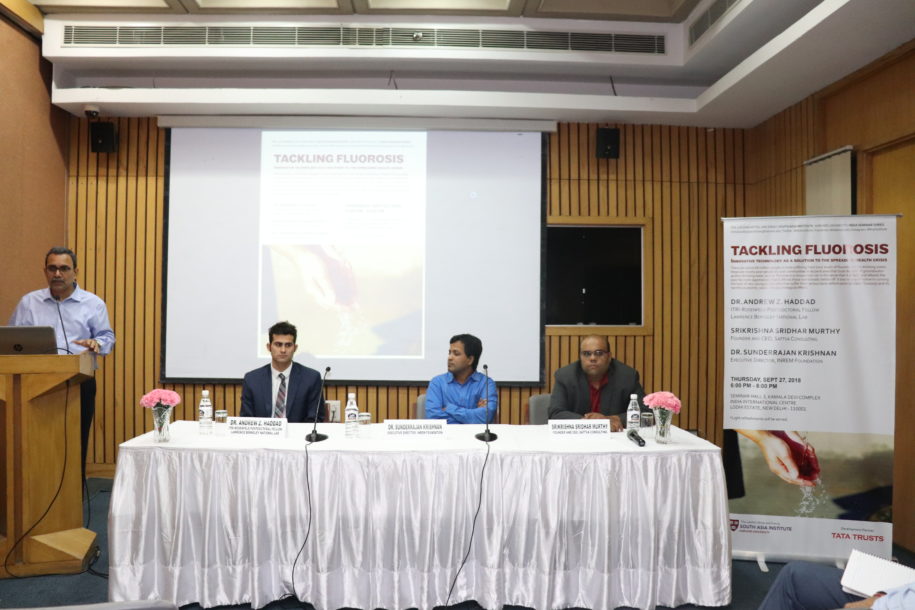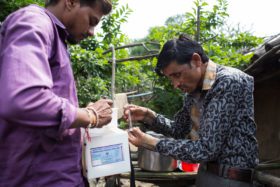
Dr. Sanjay Kumar, our India Country Director, introducing the panel at the event titled ‘Tackling Fluorosis: Innovative technology as a solution to the spreading health crisis’ . To his right, Dr. Andrew Haddad, ITR-Rosenfeld Postdoctoral Fellow at the Lawrence Berkeley National Laboratory; Dr. Sunderrajan Krishnan, Executive Director of the INREM Foundation (middle), and SriKrishna Sridhar Murthy, CEO of Sattva Consulting (extreme right).
The Lakshmi Mittal and Family South Asia Institute, Harvard University, and Harvard Global Research Support Centre India put together a panel on defluoridation of water in India, titled, “Tackling Fluorosis: Innovative Technology as a Solution to the Spreading Health Crisis”. The event was part of a project funded by the Tata Trusts-Mittal Institute initiative called “Multidisciplinary Approaches to Innovative Social Enterprises”. The panel comprised of Dr. Andrew Haddad, ITR-Rosenfeld Postdoctoral Fellow at the Lawrence Berkeley National Laboratory, Dr. Sunderrajan Krishnan, Executive Director of the INREM Foundation, and Srikrishna Sridhar Murthy, CEO of Sattva Consulting.
The project looks at scalable and affordable methods of removing fluoride from drinking water in fluoride heavy rural areas, where there is a dearth of access to even the very basic resources like proper nutrition, education, and clean drinking water. Excess fluoride in water can cause diseases such as skeletal and dental fluorosis, which, at their most severe, can result in severely stunted, abnormal growth, and damaged joints and bones. Haddad began the panel by elaborating on both the science behind current defluoridation technology used in India as well as the new technique evolved by Gadgil Lab for Energy and Water Research. The new technology, SAFR (Safe & Affordable Fluoride Removal), proposes using raw, locally-sourced bauxite ore to remove fluoride from water, a method which is 3 to 5 times cheaper, more energy efficient and sustainable than present methods of defluoridation.

Water filtration in Jhabua, M.P an area with high levels of fluorosis. Photograph credits: SAFEBillion.org
Krishnan explained how the fluoride crisis in India is a structural problem, which can only be solved through the interaction of a number of factors such as proper nutrition, alleviating calcium deficiencies, and education. However, the people who generally suffer from fluorosis are those that live in extreme poverty and do not have access to enough food, let alone education. The villagers consider the symptoms of fluorosis in a child as a curse, and tend not to believe that a constructive change is needed in their water source as they have many other issues to contend with. Thus, Krishnan talked about the need for safe water, nutrition management, and behavioural change to work together to solve this crisis.
Lastly, Murthy from Sattva Consulting emphasized the importance of a strong structural ecosystem, where all stakeholders – government, scientists, NGOs, natural resource organisations, and the community – must work together if they want to solve the fluoride crisis on a large scale. He mentioned that Sattva works to join all the stakeholders, to scale up the research and implementation, and help to build local capacity.
